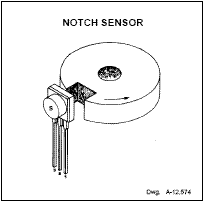Ratiometric Linear Hall Effect Sensors
Hall Effect
If an electric current flows through a conductor in a magnetic field,
the magnetic field exerts a transverse force on the moving charge
carriers which tends to push them to one side of the conductor.
This is most evident in a thin flat conductor as illustrated. A buildup
of charge at the sides of the conductors will balance this magnetic
influence, producing a measurable voltage between the two sides of
the conductor. The presence of this measurable transverse voltage
is called the Hall effect
http://230nsc1.phy-astr.gsu.edu/hbase/magnetic/hall.html
The UGN3503LT, UGN3503U, and UGN3503UA Hall-effect
sensors accurately track extremely small changes in magnetic flux
density—changes generally too small to operate Hall-effect switches.

Each Hall-effect integrated circuit includes a Hall sensing element,
linear amplifier, and emitter-follower output stage. Problems associated
with handling tiny analog signals are minimized by having the Hall cell
and amplifier on a single chip.
Application
NOTCH SENSOR
The south pole of a magnet is attached to the back of the package if
the Halleffect IC is to sense the presence of ferrous material.

GEAR TOOTH SENSOR
The north pole of a magnet is attached to the back surface if the
integrated circuit is to sense the absence of ferrous matrial.
CURRENT MONITOR
proportional output-voltage levels are dependent on magnetic flux
density at the most sensitive area of the device.







<< Home